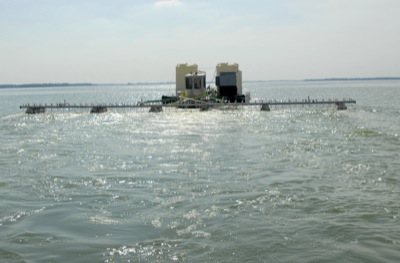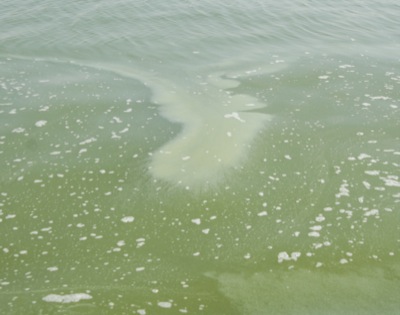Friday, July 1st, 2011
Alum application history
State's report due later this summer will show if phosphorous levels were reduced
By Nancy Allen

Photo by Nancy Allen/The Daily Standard
A boat applying alum to Grand Lake makes its last pass on the lake late Thursday afternoon. Officials hope the application, the largest ever done in the United States, will lessen blue-green algae blooms on the lake.
All of the alum is in Grand Lake but the success of the $3.4 million treatment isn't any clearer than the water.
"I'm excited that phase one of the alum project is wrapped up and I'm happy with how HAB handled the project," said Brian Miller, manager at Grand Lake St. Marys State Park. "But I want people to understand this project wasn't to end up with pristine, clear water. You don't see a real difference."
Science will be the true test of whether the treatment successfully reduced levels of phosphorous, the algae's main food source. That will be born out in a state report later this summer, said Scott Fletcher with the Ohio Department of Natural Resources.
Fletcher said Thursday that the project went smoothly and was completed on time.
"We're very pleased with how everything went considering we didn't even think we were going (to have the money) to do this until the end of February," he said.
The state last year agreed an alum treatment was needed, but the funding wasn't identified until early this year. The money came from the Ohio EPA's Water Pollution Control Loan Fund. It will not need to be repaid.
The state hired HAB Aquatic Solutions, Lincoln, Neb., to do the treatment, which began June 2. It is the largest application of alum done in a body of water in the United States.
Two application boats made their last passes Thursday evening on the lake's east side. Trails of light colored floc - which forms when the phosphorous is stripped from the water and binds to the alum - trailed the boats.
John Holz of HAB said Thursday that the alum application has increased the clarity of the water six to eight inches in some areas. But clearer water isn't the goal, phosphorous reductions are, he said.
The treatment is deemed a short-term solution to the lake's algae problems. State officials have said ongoing, smaller-dosed treatments will be needed to keep blooms at bay while watershed farmers work to reduce manure and fertilizer runoff. Most of the nutrients that enter the 13,500-acre lake comes from farmland in the 58,000-acre watershed.
In all, 1.8 million gallons of aluminum sulfate (alum) and 900,000 gallons of sodium aluminate were put into the lake. Sodium aluminate is a buffering agent that keeps pH levels from fluctuating so fish aren't stressed and it helps reduce possible damage to boat hulls.
Crews worked 14 to 16 hour days to get the job done, even working a few nights after equipping the boats with lights.
It is hoped the treatment will be enough to stave off severe algae blooms this summer that have previously curtailed the lake's recreational usage and hurt the economy. Strict water quality advisories have been placed on the lake the last two years.
The state placed a public health advisory on the lake May 19 due to algae toxins. The advisory warns against wading in or swallowing the lake's water, but deems boating and fishing OK.
"We don't know if it's alum, but for whatever reason we're a far cry off than we were last year," said Miller, who added that toxin levels are holding steady. "It's exciting to think we can boat and we can still fish even though there is an advisory."
Jet skiers and boaters were using the lake Thursday, taking advantage of warm temperatures and sunny skies. A long row of people fishing and having picnics lined the shore along the West Bank near the alum treatment staging area, which will be dismantled starting Tuesday.
The alum treatment was scaled down from a $5 million project after snow melt and spring rains washed higher than usual amounts of phosphorous into the lake. The state applied a concentrated dose of alum to only the 4,900-acre center of the lake where phosphorous levels are highest instead of treating the entire 13,500-acre lake with a low dose.
Miller remained optimistic about the summer and the upcoming Fourth of July weekend.
"It's exciting to know we can still boat and fish and we're going to have Freedom Days with fireworks over the lake Saturday night," he said. "Our campground electric sites are completely full and the other sites will probably fill and we've been mowing and sprucing up ... we're excited and ready for this weekend to be here."

Photo by Nancy Allen/The Daily Standard
Alum and phosphorous form a milky, greenish floc after alum was applied to a portion of Grand Lake on Thursday.


